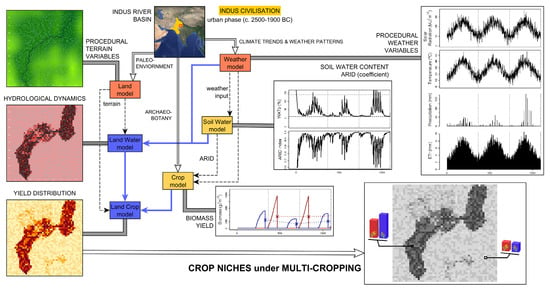Weather, Land and Crops in the Indus Village Model: A Simulation Framework for Crop Dynamics under Environmental Variability and Climate Change in the Indus Civilisation
Abstract
1. Introduction
2. Materials and Methods
2.1. Indus Village Model: A Road Map
2.2. Weather Model
2.3. Soil Water Model
2.4. Crop Model
Crop Selection and Parametrization
2.5. Land Model
2.6. Land Water Model
- Estimation of soil water capacity thresholds or horizons according to soil texture. Saturation and permanent wilting points are approximated using linear models factoring the percentage of clay in the soil (i.e., p_soil_%clay) based on data offered by the Soil and Water Assessment Tool (SWAT) Theoretical Documentation [51] (p. 149).
- Redistribution of surface water (run-off and inundation). The run-off exchange algorithm combines the calculations in the soil water model with an algorithm in charge of redistribution, which was already implemented in the land model [48], and another to calculate run-off volume moving from one land unit to another, which was adapted from a model about flood impact [52].
- Impact of water on ecological communities and cover. When water input exceeds the capacity of the soil, surface water accumulates as an additional type of ecological component. Given a volume of surface water (mm·m−2), the percentage of land unit area (1 ha or 10,000 m2) covered by water is estimated assuming a bankfull width/depth ratio of 12 for all land units and a bankfull width equal to or less than land unit width (100 m). The width/depth ratio of 12 has been empirically identified as the most common value universally, and is a consequence of the physical processes governing the distribution of energy and resultant sediment transport [53]. The expansion of water surface is at the expense of dry ecological components (i.e., grass, brush, and wood), which are assumed to be affected evenly. When dry land is available, all ecological components grow following a logistic growth model, where the carrying capacity is proportional to the value in the initial ecological community configuration (given by the land model), minus the influence of water stress. Similar to the crop model, water stress over grass, brush, and wood is modeled in proportion to ARID and a water stress sensitivity coefficient. Both the intrinsic growth rate and water stress sensitivity, as well as the maximum root depth used to calculate ARID, are controlled as parameters imported from the “ecologicalCommunityTable.csv”.
2.7. Land Crop Model
2.8. Experimental Design
- Experiment 0 serves as a baseline reference for further experiments by running the crop model for each of the six crops selected using empirical weather data instead of data simulated with the weather model. Data were obtained in the NASA POWER project Data Access Viewer and correspond to the location of the archaeological site of Rakhigarhi in Haryana, India, between 1 January 1984 and 31 December 2007 (24 years).
- Experiment 1 executed the crop model for 25 random number generator seeds and 30 years (total sample of 750 unique years), running in parallel for each of the six crops selected. The goal was to compare yield and water stress levels of crops under the default parameter configuration, which includes a specific configuration of the weather model parameters that aims at approximating the data used in experiment 0 (see calibration process in [54]).
- Experiment 2 is equivalent to experiment 1 in all aspects, except for varying stochastically (uniform probability distribution) the precipitation absolute total per year (precipitation_yearlyMean) and the winter/summer ratio of precipitation or the average plateau value of the cumulative curve of daily precipitation (precipitation_ dailyCum_plateauValue_yearlyMean). This experiment aimed at exposing the effect of precipitation annual volume and seasonality on crop-specific ARID and yield.
- Experiment 3 executed the land crop model for 10 random number generator seeds and 5 years (total sample of 50 unique years), using five preselected terrains (2500 land units) and a default parameter configuration, both aimed at approximating past conditions in Haryana. Frequency was kept constant and homogeneous throughout all land units, while intensity was fixed at 50% throughout all runs.
- Experiment 4 is equivalent to experiment 3, except for varying stochastically the volume of river water inflow or, more specifically, the water stage increment (mm·m−2) per unit of flow accumulation at the river’s starting land unit (riverWaterPerFlow Accumulation).
- Experiment 5 is again equivalent to experiment 3, except for varying stochastically (uniform probability distribution) the share of each crop in frequency within land units. The variation of crop frequencies aims at addressing crop choice factors by evidencing the effect of relative frequencies on total production per land unit (i.e., sum of all elements in p_crop_totalYield).
3. Results
3.1. Soil Water and Crop Yield in One-Land Unit Systems
- Solar radiation and temperature: Springs are warmer and sunnier, summers are colder and less sunny, and autumns are warmer and sunnier. The distribution of both solar radiation and temperature is skewed and deformed when compared to the annual sinusoidal curve generated by the model. The annual maxima are reached one to two months before the summer solstice, and there is a considerable depression of both solar radiation and temperature due to the incidence of the monsoon.
- Precipitation. The summer monsoon tends to start and end sooner, while the winter rainy season is generally less intense. Differences in precipitation indicate the difficulty of representing the nuances of the two rains pattern found in the region. Daily maxima are also considerably lower, though this is not only a problem of misrepresentation, but also an effect of the limited sample size in the modern data.
3.2. Soil Water and Crop Yield under Terrain-Like Systems
- As a general rule, the total production of a land unit will increase with the more area that is used for proso millet, irrespective of its position, given the intrinsic high productivity and low sensitivity to water stress of this crop. Note how, in Figure 11, the range of correlation for this crop remains positive throughout all land units and terrains.
- Higher proportions of the more water-demanding crops will only tend to raise total production if the land unit is located in or around drainage branches and, particularly, inundation areas, in addition to having soil and cover conditions that facilitate lower .
4. Discussion and Conclusions
4.1. Crop Choice Dilemma
- Crop selection. There are a number of crops to be produced that are both available and required by society, given a broader economic and cultural context.
- Crop diversity. These crops are diverse as per their intrinsic biological traits, including those affecting when and how their growing cycle unfolds and, particularly, how sensitive these are to water stress.
- Limited means of production and workforce. Farming households, both separately and as a collective, count with a limited amount of land, labor, and other resources (e.g., tools, raw materials, fuel) to be invested in growing crops at any given time. Considering a pre-industrial agricultural system, extreme intensification of land use (i.e., near 100% of land unit area used for crops) is deemed neither desirable nor possible.
- Seasonality. Weather is highly variable within a year, with precipitation concentrating in seasons (two rainy seasons, two dry seasons).
- Climate-driven variability. There is a high interannual variation in weather, with great differences in the amount and distribution of precipitation between consecutive years.
- Local environmental diversity. Areas flooded by passing rivers and those down the water flow chain (e.g., dry channels, seasonal streams) represent a special type of local environment. This area is sharply separated from most of the remaining land, offering privileged crop-growing conditions with low, or no, water stress.
- Regional environmental diversity. The conditions shaping weather (seasonality and climate-driven variability), relief, soil properties, and ecology vary greatly between localities within the same cultural region, confronting the same cultural substratum to many potential contexts for the crop choice dilemma.
4.2. Risk in the Crop Choice Dilemma
4.3. Risk Mitigation Strategies
4.4. Implications to IC Urbanization
Author Contributions
Funding
Institutional Review Board Statement
Informed Consent Statement
Data Availability Statement
Acknowledgments
Conflicts of Interest
References
- Possehl, G.L. The Indus Civilization: A Contemporary Perspective; AltaMira Press: Welnut Creek, CA, USA, 2002. [Google Scholar]
- Wright, R.P. The Ancient Indus: Urbanism, Economy and Society. Case Studies in Early Societies; Cambridge University Press: Cambridge, UK, 2010. [Google Scholar]
- Kenoyer, J.M. Indus urbanism: New perspectives in its origin and character. In The Ancient City: New Perspectives in the Old and New World; Marcus, J., Sablof, J.A., Eds.; SAR: Santa Fe, NM, USA, 2008; pp. 85–109. [Google Scholar]
- Green, A.S.; Petrie, C.A. Landscapes of Urbanization and De-Urbanization: A Large-Scale Approach to Investigating the Indus Civilization’s Settlement Distributions in Northwest India. J. Field Archaeol. 2018, 43, 284–299. [Google Scholar] [CrossRef] [PubMed]
- Wilkinson, T.C. Trans-Regional Routes and Material Flows in Transcaucasia, Eastern Anatolia and Western Central Asia, c. 3000-1500 BC; Sidestone Press: Leiden, The Netherlands, 2014. [Google Scholar]
- Petrie, C.A. Diversity, variability, adaptation and ‘fragility’ in the Indus Civilisation. In The Evolution of Fragility: Setting the Terms; Yoffe, N., Ed.; McDonald Institute Monographs Conversations: Cambridge, UK, 2019; pp. 109–134. [Google Scholar]
- Dixit, Y.; Hodell, D.A.; Giesche, A.; Tandon, S.K.; Gázquez, F.; Saini, H.S.; Skinner, L.C.; Mujtaba, S.A.I.; Pawar, V.; Singh, R.N.; et al. Intensified summer monsoon and the urbanization of Indus Civilization in northwest India. Sci. Rep. 2018, 8, 4225. [Google Scholar] [CrossRef] [PubMed]
- Giesche, A.; Staubwasser, M.; Petrie, C.A.; Hodell, D.A. Indian winter and summer monsoon strength over the 4.2 ka BP event in foraminifer isotope records from the Indus River delta in the Arabian Sea. Clim. Past 2019, 15, 73–90. [Google Scholar] [CrossRef]
- Giesche, A. A Multi-Archive Reconstruction of Holocene Summer and Winter Monsoon Variability in NW South Asia. Ph.D. Thesis, University of Cambridge, Cambridge, UK, 2020. [Google Scholar]
- Petrie, C.A.; Singh, R.N.; Bates, J.; Dixit, Y.; French, C.A.I.; Hodell, D.A.; Jones, P.J.; Lancelotti, C.; Lynam, F.; Neogi, S.; et al. Adaptation to Variable Environments, Resilience to Climate Change: Investigating Land, Water and Settlement in Indus Northwest India. Curr. Anthropol. 2017, 58, 1–30. [Google Scholar] [CrossRef]
- Chase, B.; Meiggs, D.; Ajithprasad, P. Pastoralism, climate change, and the transformation of the Indus Civilization in Gujarat: Faunal analyses and biogenic isotopes. J. Anthropol. Archaeol. 2020, 59, 101173. [Google Scholar] [CrossRef]
- Chase, B.; Ajithprasad, P.; Rajesh, S.V.; Patel, A.; Sharma, B. Materializing Harappan identities: Unity and diversity in the borderlands of the Indus Civilization. J. Anthropol. Archaeol. 2014, 35, 63–78. [Google Scholar] [CrossRef]
- Bates, J. The Published Archaeobotanical Data from the Indus Civilisation, South Asia, c.3200–1500BC. J. Open Archaeol. Data 2019, 7, 5. [Google Scholar] [CrossRef]
- Petrie, C.A.; Bates, J. ‘Multi-cropping’, Intercropping and Adaptation to Variable Environments in Indus South Asia. J. World Prehistory 2017, 30, 81–130. [Google Scholar] [CrossRef]
- Fuller, D.Q. Agricultural Origins and Frontiers in South Asia: A Working Synthesis. J. World Prehistory 2006, 20, 1–86. [Google Scholar] [CrossRef]
- Weber, S.; Kashyap, A.; Harriman, D. Does size matter: The role and significance of cereal grains in the Indus civilization. Archaeol. Anthropol. Sci. 2010, 2, 35–43. [Google Scholar] [CrossRef]
- Weber, S.A.; Barela, T.; Lehman, H. Ecological Continuity: An explanation for agricultural diversity in the Indus Civilisation and beyond. Man Environ. 2010, XXXV, 62–75. [Google Scholar]
- Pokharia, A.K.; Srivastava, C. Current Status of Archaeobotanical Studies in Harappan Civilization: An archaeological perspective. Heritage J. Multidiscip. Stud. Archaeol. 2013, 1, 118–137. [Google Scholar]
- Baudouin, J.P.; Herzog, M.; Petrie, C.A. Cross-validating precipitation datasets in the Indus River Basin. Hydrol. Earth Syst. Sci. (HESS) 2020, 24, 427–450. [Google Scholar] [CrossRef]
- Baudouin, J.P.J.P.; Herzog, M.; Petrie, C.A. Contribution of cross-mountain moisture transport to precipitation in the upper Indus River Basin. Mon. Weather. Rep. 2020, 148, 2801–2818. [Google Scholar] [CrossRef]
- Angourakis, A.; Bates, J.; Baudouin, J.P.; Giesche, A.; Ustunkaya, M.C.; Wright, N.; Singh, R.N.; Petrie, C.A. How to ‘downsize’ a complex society: An agent-based modeling approach to assess the resilience of Indus Civilisation settlements to past climate change. Environ. Res. Lett. 2020, 15, 115004. [Google Scholar] [CrossRef]
- Axtell, R.L.; Epstein, J.M.; Dean, J.S.; Gumerman, G.J.; Swedlund, A.C.; Harburger, J.; Chakravarty, S.; Hammond, R.; Parker, J.; Parker, M. Population growth and collapse in a multiagent model of the Kayenta Anasazi in Long House Valley. Proc. Natl. Acad. Sci. USA 2002, 99, 7275–7279. [Google Scholar] [CrossRef]
- Kohler, T.A.; Gumerman, G.J.; Reynolds, R.G. Simulating ancient societies. Sci. Am. 2005, 293, 76–84. [Google Scholar] [CrossRef]
- Kohler, T.A.; van der Leeuw, S. The Model-Based Archaeology of Socionatural Systems; AdvanceResearch Press: Santa Fe, NM, USA, 2007. [Google Scholar]
- Wilkinson, T.J.; Gibson, M.; Widell, M. (Eds.) Models of Mesopotamian Landscapes: How Small-Scale Processes Contributed to the Growth of Early Civilizations; BAR International Series 2552; Archaeopress: Oxford, UK, 2013. [Google Scholar]
- Madella, M.; Rondelli, B.; Lancelotti, C.; Balbo, A.L.; Zurro, D.; Rubio Campillo, X.; Stride, S. Introduction to Simulating the Past. J. Archaeol. Method Theory 2014, 21, 251–257. [Google Scholar] [CrossRef]
- Barceló, J.A.; Del Castillo, F. Simulating Prehistoric and Ancient Worlds; Series Title: Computational Social Sciences; Springer International Publishing: Cham, Switzerland, 2016. [Google Scholar]
- Cegielski, W.H.; Rogers, J.D. Rethinking the role of Agent-Based Modeling in archaeology. J. Anthropol. Archaeol. 2016, 41, 283–298. [Google Scholar] [CrossRef]
- Romanowska, I.; Crabtree, S.A.; Harris, K.; Davies, B. Agent-Based Modeling for Archaeologists: Part 1 of 3. Adv. Archaeol. Pract. 2019, 7, 178–184. [Google Scholar] [CrossRef]
- Saqalli, M.; Vander Linden, M. Integrating Qualitative and Social Science Factors in Archaeological Modeling, 1st ed.; Computational Social Sciences; Springer: Cham, Switzerland, 2019. [Google Scholar]
- Jarman, M.R.; Vita-Finzi, C.; Higgs, E.S. Site catchment analysis in archaeology. Man Settl. Urban. 1972, 61, 66. [Google Scholar]
- Lowder, S.K.; Skoet, J.; Raney, T. The Number, Size, and Distribution of Farms, Smallholder Farms, and Family Farms Worldwide. World Dev. 2016, 87, 16–29. [Google Scholar] [CrossRef]
- Wilensky, U. NetLogo; Center for Connected Learning and Computer-Based Modeling, Northwestern University: Evanston, IL, USA, 1999. [Google Scholar]
- Allaire, J.J.; Xie, Y.; McPherson, J.; Luraschi, J.; Ushey, K.; Atkins, A.; Wickham, H.; Cheng, J.; Chang, W.; Iannone, R. Rmarkdown: Dynamic Documents for R; GitHub: San Francisco, CA, USA, 2021; Available online: https://github.com/rstudio/rmarkdown (accessed on 10 January 2022).
- R Core Team. R: A Language and Environment for Statistical Computing; R Foundation for Statistical Computing: Vienna, Austria, 2020. [Google Scholar]
- Angourakis, A. Two-Rains/Indus-Village-Model: The Indus Village Model Development Files (May 2021) (v0.4). Zenodo. 2021. Available online: https://zenodo.org/record/4814255#.YnNwvtNByUk (accessed on 10 January 2022).
- Allen, R.G.; Pereira, L.S.; Raes, D.; Smith, M. Crop Evapotranspiration—FAO Irrigation and Drainage Paper No. 56; FAO: Rome, Italy, 1998. [Google Scholar]
- Suleiman, A.A.; Hoogenboom, G. Comparison of Priestley-Taylor and FAO-56 Penman-Monteith for Daily Reference Evapotranspiration Estimation in Georgia. J. Irrig. Drain. Eng. 2007, 133, 175–182. [Google Scholar] [CrossRef]
- Wallach, D.; Makowski, D.; Jones, J.W.; Brun, F. Working with Dynamic Crop Models, 2nd ed.; Academic Press: Cambridge, MA, USA, 2014. [Google Scholar]
- Woli, P.; Jones, J.W.; Ingram, K.T.; Fraisse, C.W. Agricultural Reference Index for Drought (ARID). Agron. J. 2012, 104, 287. [Google Scholar] [CrossRef]
- Hoogenboom, G.; Porter, C.; Boote, K.J.; Singh, U.; White, J.; Hunt, L.; Ogoshi, R.; Lizaso, J.I.; Koo, J.; Asseng, S.; et al. Decision Support System for Agrotechnology Transfer (DSSAT) Version 4.7.5; DSSAT Foundation: Gainesville, FL, USA, 2019. [Google Scholar]
- Holzworth, D.P.; Snow, V.; Janssen, S.; Athanasiadis, I.N.; Donatelli, M.; Hoogenboom, G.; White, J.W.; Thorburn, P. Agricultural production systems modeling and software: Current status and future prospects. Environ. Model. Softw. 2015, 72, 276–286. [Google Scholar] [CrossRef]
- Zhao, C.; Liu, B.; Xiao, L.; Hoogenboom, G.; Boote, K.J.; Kassie, B.T.; Pavan, W.; Shelia, V.; Kim, K.S.; Hernandez-Ochoa, I.M.; et al. A SIMPLE crop model. Eur. J. Agron. 2019, 104, 97–106. [Google Scholar] [CrossRef]
- van Oosterom, E.J.; O’Leary, G.J.; Carberry, P.S.; Craufurd, P.Q. Simulating growth, development, and yield of tillering pearl millet. III. Biomass accumulation and partitioning. Field Crop. Res. 2002, 79, 85–106. [Google Scholar] [CrossRef][Green Version]
- Calamai, A.; Masoni, A.; Marini, L.; Dell’acqua, M.; Ganugi, P.; Boukail, S.; Benedettelli, S.; Palchetti, E. Evaluation of the Agronomic Traits of 80 Accessions of Proso Millet (Panicum miliaceum L.) under Mediterranean Pedoclimatic Conditions. Agriculture 2020, 10, 578. [Google Scholar] [CrossRef]
- Ventura, F.; Vignudelli, M.; Poggi, G.M.; Negri, L.; Dinelli, G. Phenological stages of Proso millet (Panicum miliaceum L.) encoded in BBCH scale. Int. J. Biometeorol. 2020, 64, 1167–1181. [Google Scholar] [CrossRef]
- Spate, O.H.K.; Learmonth, A.T.A. India and Pakistan: A General and Regional Geography; Routledge: Milton Park, UK, 2017. [Google Scholar]
- Jenson, S.K.; Domingue, J.O. Extracting Topographic Structure from Digital Elevation Data for Geographic Information System Analysis. Photogramm. Eng. Remote Sens. 1988, 54, 1593–1600. [Google Scholar]
- Huang, P.C.; Lee, K.T. A simple depression-filling method for raster and irregular elevation datasets. J. Earth Syst. Sci. 2015, 124, 1653–1665. [Google Scholar] [CrossRef]
- Cronshey, R.G. Urban Hydrology for Small Watersheds, Technical Release 55 (TR-55); Technical report; United States Department of Agriculture, Soil Conservation Service, Engineering Division: Washington, DC, USA, 1986; ISBN NTIS #PB87101580.
- Neitsch, S.; Arnold, J.; Kiniry, J.; Williams, J. Soil & Water Assessment Tool Theoretical Documentation Version 2009; Technical Report No. 406; Texas Water Resources Institute-Texas A&M University: College Station, TX, USA, 2011; Available online: https://swat.tamu.edu/media/99192/swat2009-theory.pdf (accessed on 10 January 2022).
- Yang, L.E.; Scheffran, J.; Süsser, D.; Dawson, R.; Chen, Y.D. Assessment of Flood Losses with Household Responses: Agent-Based Simulation in an Urban Catchment Area. Environ. Model. Assess. 2018, 23, 369–388. [Google Scholar] [CrossRef]
- Rosgen, D.; Silvey, H. Applied River Morphology; Wildland Hydrology Books: Fort Collins, CO, USA, 1996. [Google Scholar]
- Angourakis, A. Two-Rains/Quaternary_Angourakis-et-al-2022_Rproject: Quaternary_Angourakis-et-al-2022_Rproject–Submission Version Updated. Zenodo. 2022. Available online: https://zenodo.org/record/6478557#.YnNv39NByUk (accessed on 10 January 2022).
- USDA. Soil Mechanics Level 1, Module 3-USDA Textural Classification. In Study Guide; United States Department of Agriculture: Washington, DC, USA, 1987; pp. 1–48. Available online: https://www.nrcs.usda.gov/Internet/FSE_DOCUMENTS/stelprdb1044818.pdf (accessed on 10 January 2022).
- Galinato, M.I.; Moody, K.; Piggin, C.M. Upland Rice Weeds of South and Southeast Asia; International Rice Research Institude: Kyoto, Japan, 1999. [Google Scholar]
- Akponikpè, P.B.I.; Minet, J.; Gérard, B.; Defourny, P.; Bielders, C.L. Spatial fields’ dispersion as a farmer strategy to reduce agro-climatic risk at the household level in pearl millet-based systems in the Sahel: A modeling perspective. Agric. For. Meteorol. 2011, 151, 215–227. [Google Scholar] [CrossRef]
- de Rouw, A. Improving yields and reducing risks in pearl millet farming in the African Sahel. Agric. Syst. 2004, 81, 73–93. [Google Scholar] [CrossRef]
- Fernández-Rivera, S.; Hiernaux, P.; Williams, T.O.; Turner, M.D.; Schlecht, E.; Salla, A.; Ayantunde, A.A.; Sangaré, M. Nutritional constraints to grazing ruminants in the millet-cowpea-livestock farming system of the Sahel. In Coping with Feed Scarcity in Smallholder Livestock Systems in Developing Countries; Animal Sciences Group & Swiss Federal Institute of Technology & International Livestock Research Institute: Reading, UK; Wageningen, The Netherlands; Nairobi, Kenya, 2005; pp. 157–182. Available online: https://hdl.handle.net/10568/50886 (accessed on 10 January 2022).
- Matthews, R.B.; Pilbeam, C. modeling the long-term productivity and soil fertility of maize/millet cropping systems in the mid-hills of Nepal. Agric. Ecosyst. Environ. 2005, 111, 119–139. [Google Scholar] [CrossRef]
- Ruiz-Giralt, A.; Biagetti, S.; Madella, M.; Lancelotti, C. Is yearly rainfall amount a good predictor for agriculture viability in drylands? Modeling traditional cultivation practices of drought-resistant crops: An ethnographic approach for the study of long-term resilience and sustainability. Technical report, EcoEvoRxiv. 11 May 2020; pre-print. [Google Scholar]
- Appadurai, A. gastro-politics in Hindu South Asia. Am. Ethnol. 1981, 8, 494–511. [Google Scholar] [CrossRef]
- Appadurai, A. The Social Life of Things: Commodities in Cultural Perspective; Cambridge University Press: Cambridge, UK, 1986. [Google Scholar]
- Hastorf, C.A. The Social Archaeology of Food: Thinking about Eating from Prehistory to the Present; Cambridge University Press: Cambridge, UK, 2016. [Google Scholar]
- Madella, M. Of Crops and Food: A Social Perspective on Rice in the Indus Civilization; University of Arizona: Tucson, AZ, USA, 2014. [Google Scholar]
- Rowan, E. The sensory experiences of food consumption. In The Routledge Handbook of Sensory Archaeology; Routledge: Milton Park, UK, 2020; 17p. [Google Scholar]
- Twiss, K. The Archaeology of Food and Social Diversity. J. Archaeol. Res. 2012, 20, 357–395. [Google Scholar] [CrossRef]
- Goody, J.; Goody, J.R. Cooking, Cuisine and Class: A Study in Comparative Sociology; Cambridge University Press: Cambridge, UK, 1982. [Google Scholar]
- Hamilakis, Y. Archaeology and the Senses: Human Experience, Memory, and Affect; Cambridge University Press: Cambridge, UK, 2013. [Google Scholar]
- van der Veen, M. The materiality of plants: Plant—People entanglements. World Archaeol. 2014, 46, 799–812. [Google Scholar] [CrossRef]
- Smith, M.L. The Archaeology of Food Preference. Am. Anthropol. 2006, 108, 480–493. [Google Scholar] [CrossRef]
- Twiss, K.C. The Archaeology of Food: Identity, Politics, and Ideology in the Prehistoric and Historic Past; Cambridge University Press: Cambridge, UK, 2019. [Google Scholar]
- Chakraborty, K.S.; Slater, G.F.; Miller, H.M.L.; Shirvalkar, P.; Rawat, Y. Compound specific isotope analysis of lipid residues provides the earliest direct evidence of dairy product processing in South Asia. Sci. Rep. 2020, 10, 16095. [Google Scholar] [CrossRef]
- Fuller, D.Q. Pathways to Asian Civilizations: Tracing the Origins and Spread of Rice and Rice Cultures. Rice 2011, 4, 78–92. [Google Scholar] [CrossRef]
- Kashyap, A.; Weber, S. Starch Grain Analysis and Experiments Provide Insights into Harappan Cooking Practices. In Connections and Complexity; Routledge: Milton Park, UK, 2013; 18p. [Google Scholar]
- Reddy, S.N. Discerning Palates of the Past: An Ethnoarchaeological Study of Crop Cultivation and Plant Usage in India; Number 5 in International Monographs in Prehistory: Ethnoarchaeological Series; Berghahn Books: New York, NY, USA, 2003; ISBN 9781879621374. [Google Scholar]
- Suryanarayan, A.; Cubas, M.; Craig, O.E.; Heron, C.P.; Shinde, V.S.; Singh, R.N.; O’Connell, T.C.; Petrie, C.A. Lipid residues in pottery from the Indus Civilisation in northwest India. J. Archaeol. Sci. 2021, 125, 105291. [Google Scholar] [CrossRef] [PubMed]
- Winterhalder, B. Risk and decision-making. In Oxford Handbook of Evolutionary Psychology; Oxford University Press: Oxford, UK, 2007; pp. 433–446. [Google Scholar]
- Brookfield, H.C. Exploring Agrodiversity; Perspectives in Biological Diversity Series; Columbia University Press: New York, NY, USA, 2001. [Google Scholar]
- Bates, J. Kitchen gardens, wild forage and tree fruits: A hypothesis on the role of the Zaid season in the indus civilisation (c.3200-1300 BCE). Archaeol. Res. Asia 2020, 21, 100175. [Google Scholar] [CrossRef]
- Cashdan, E. Risk and Uncertainty in Tribal and Peasant Economies; Routledge: Milton Park, UK, 2019. [Google Scholar]
- Winterhalder, B.; Puleston, C.; Ross, C. Production risk, inter-annual food storage by households and population-level consequences in seasonal prehistoric agrarian societies. Environ. Archaeol. 2015, 20, 337–348. [Google Scholar] [CrossRef]
- Bates, J.; Petrie, C.A.; Singh, R.N. Cereals, calories and change: Exploring approaches to quantification in Indus archaeobotany. Archaeol. Anthropol. Sci. 2017, 10, 1703–1716. [Google Scholar] [CrossRef]
- Childe, V.G. The Urban Revolution. Town Plan. Rev. 1950, 21, 3–17. [Google Scholar] [CrossRef]
- Fuller, D.Q.; Rowlands, M. Ingestion and Food Technologies: Maintaining Differences over the long-term in West, South and East Asia. In Interweaving Worlds—Systematic Interactions in Eurasia, 7th to 1st Millennia BC. Essays from a Conference in Memory of Professor Andrew Sherratt; Oxbow Books: Oxford, UK, 2011; pp. 37–60. [Google Scholar]
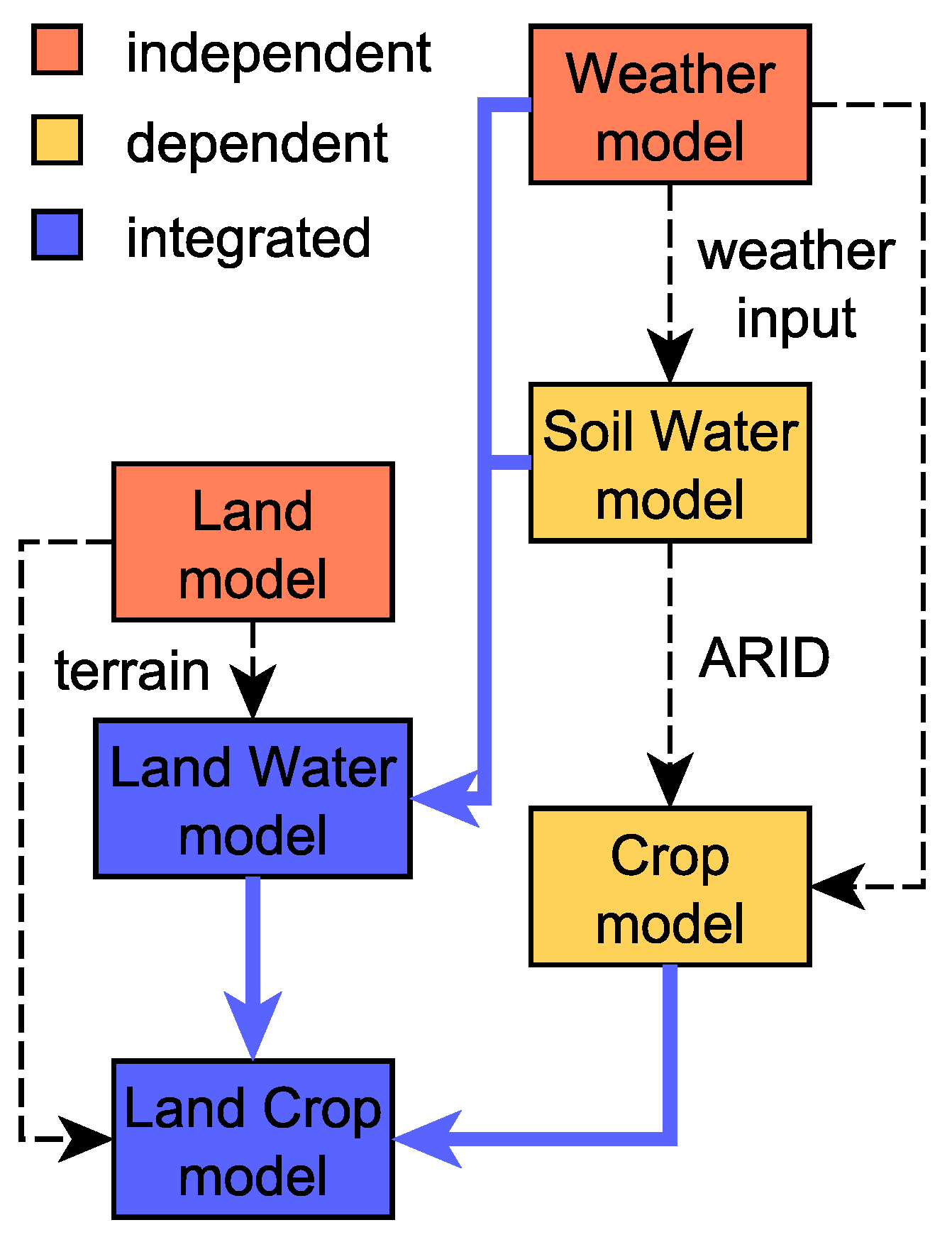

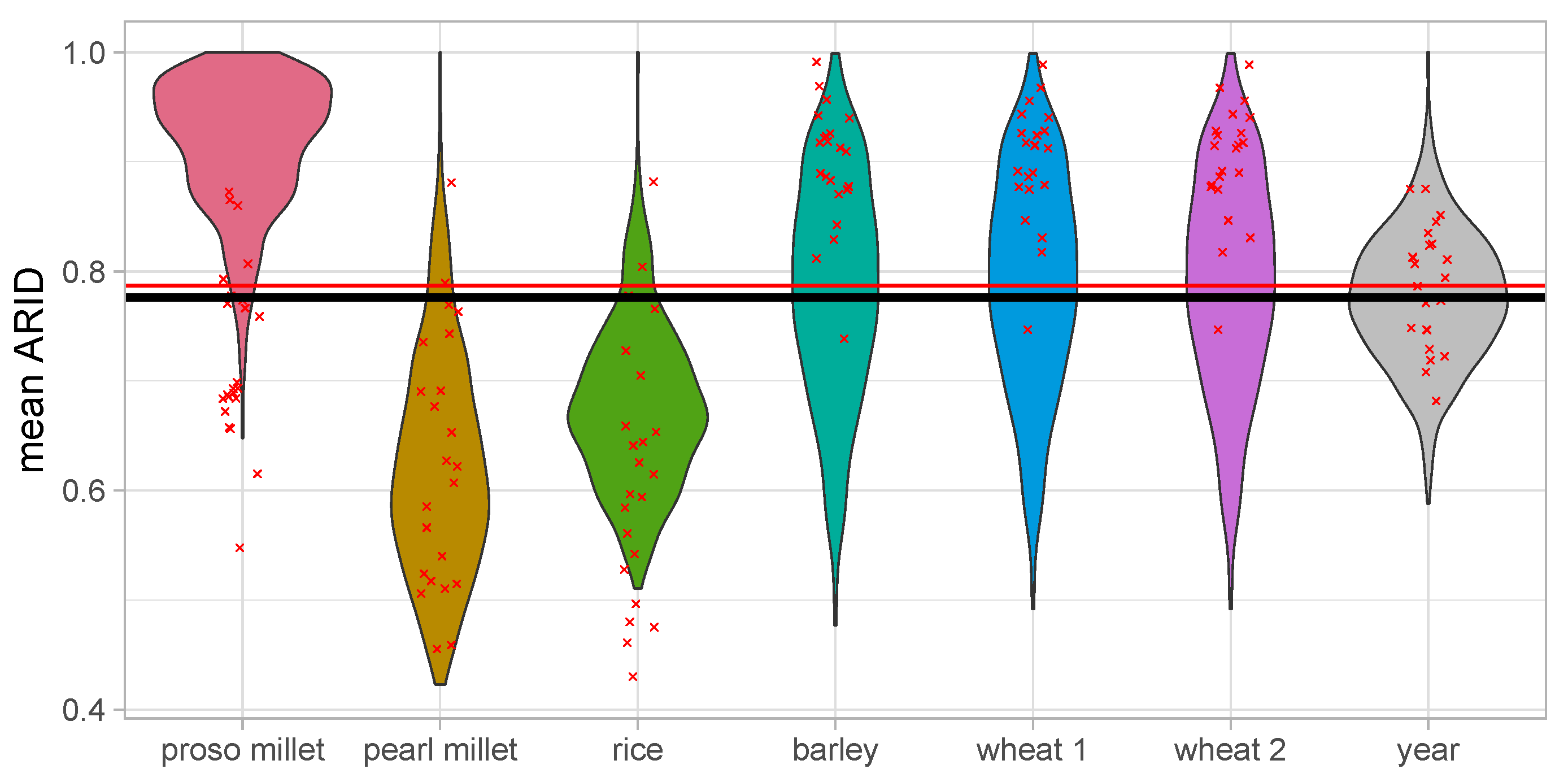
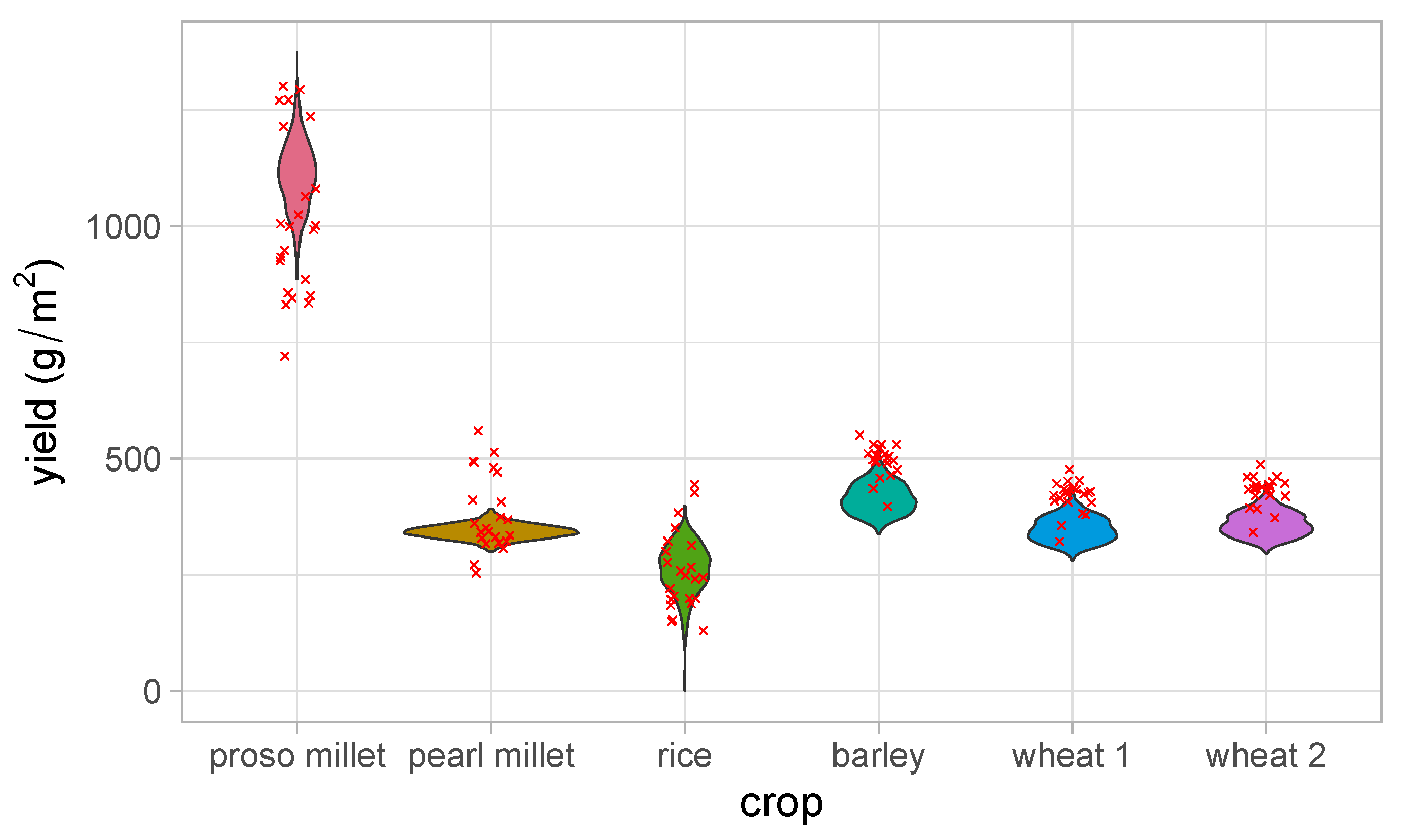
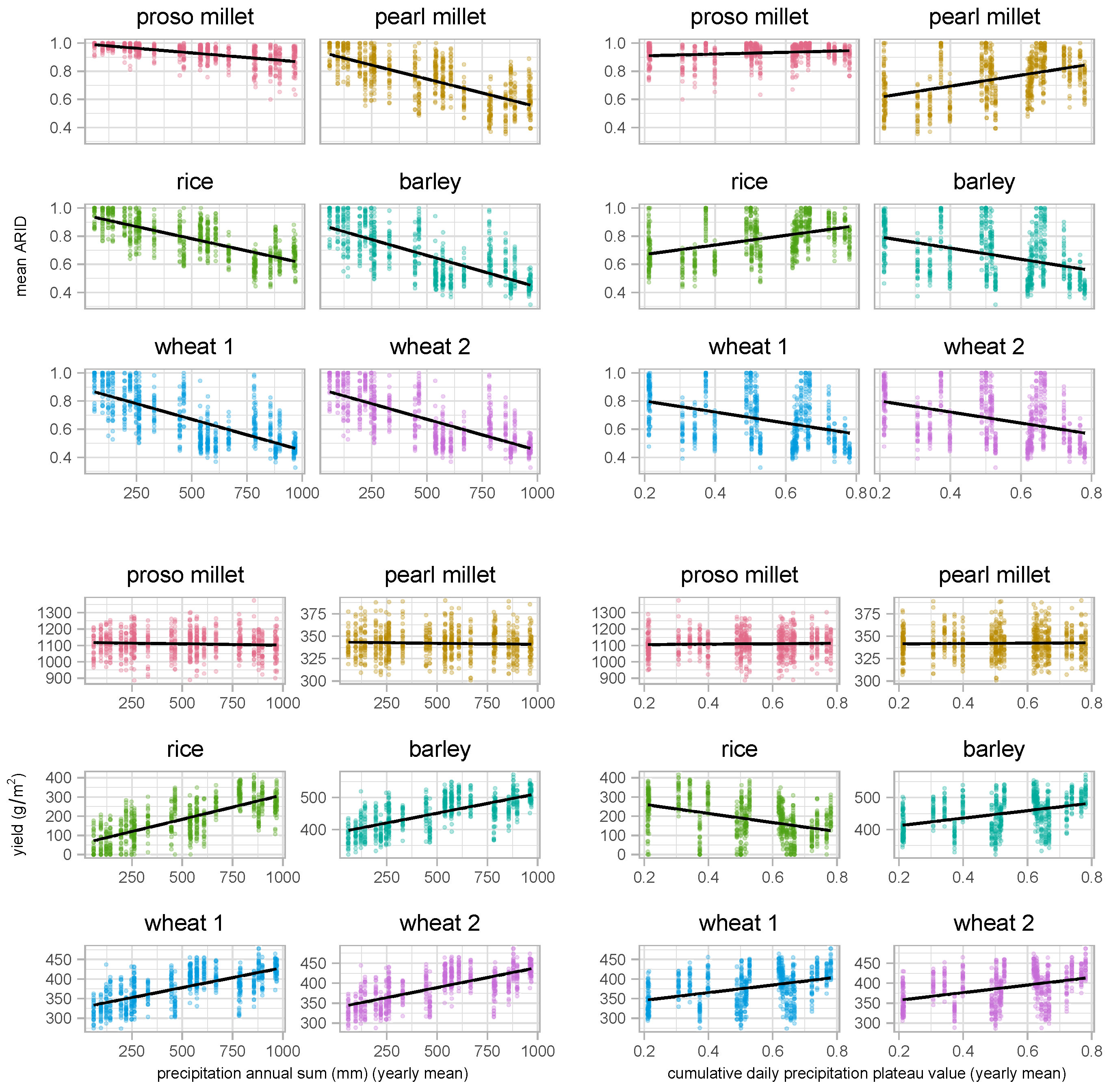
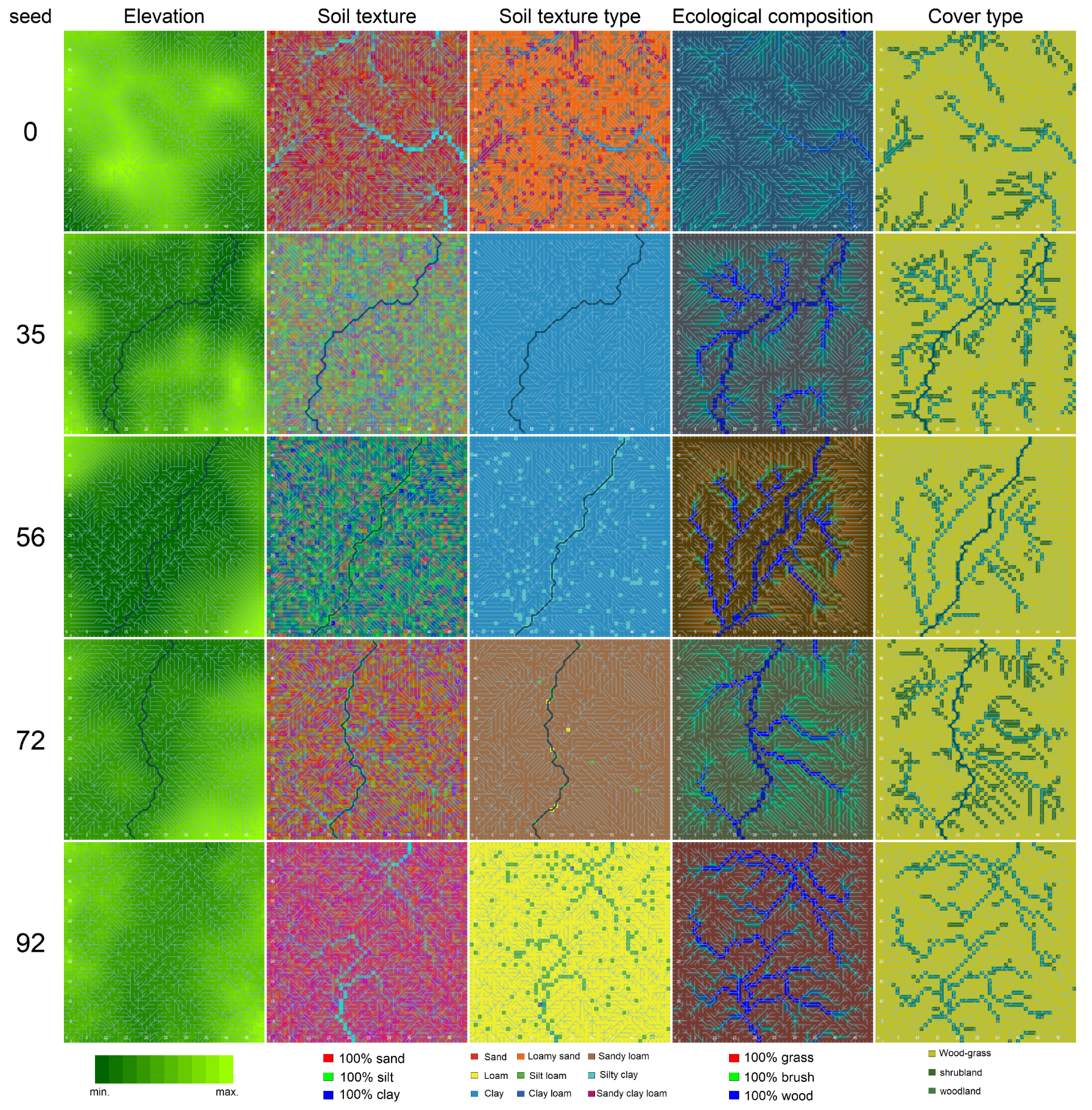


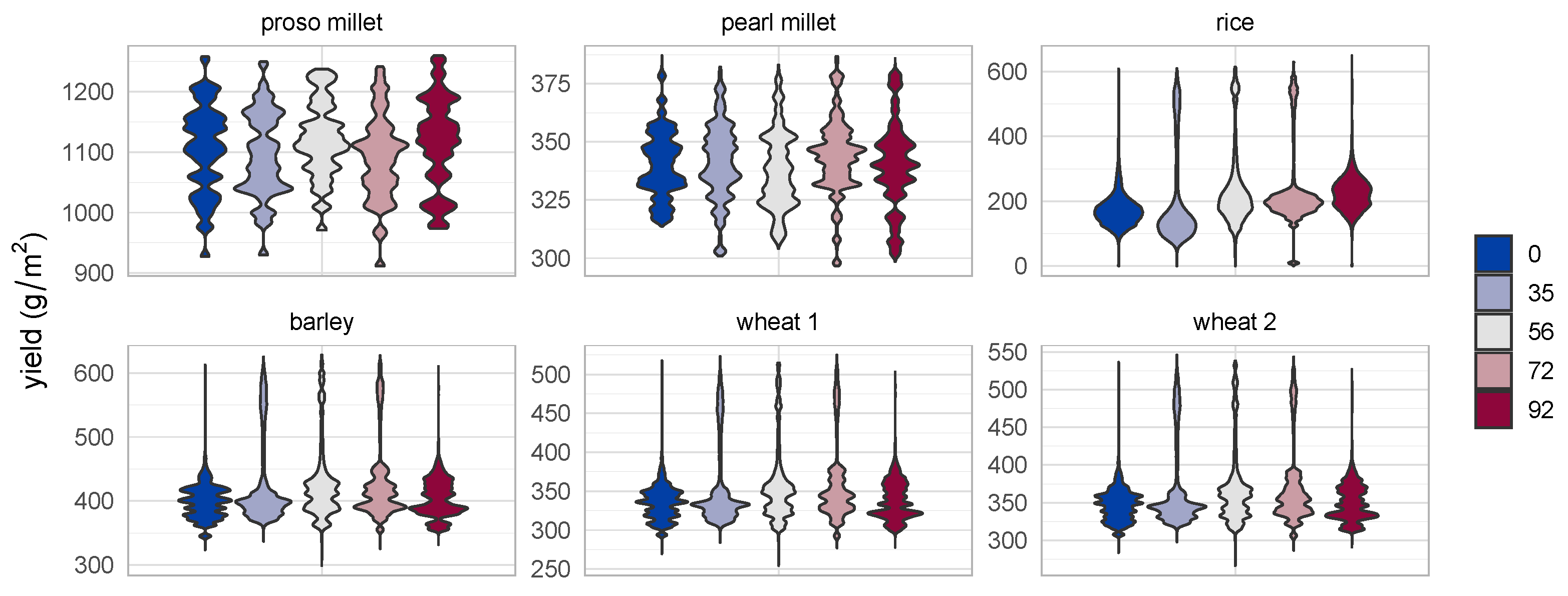
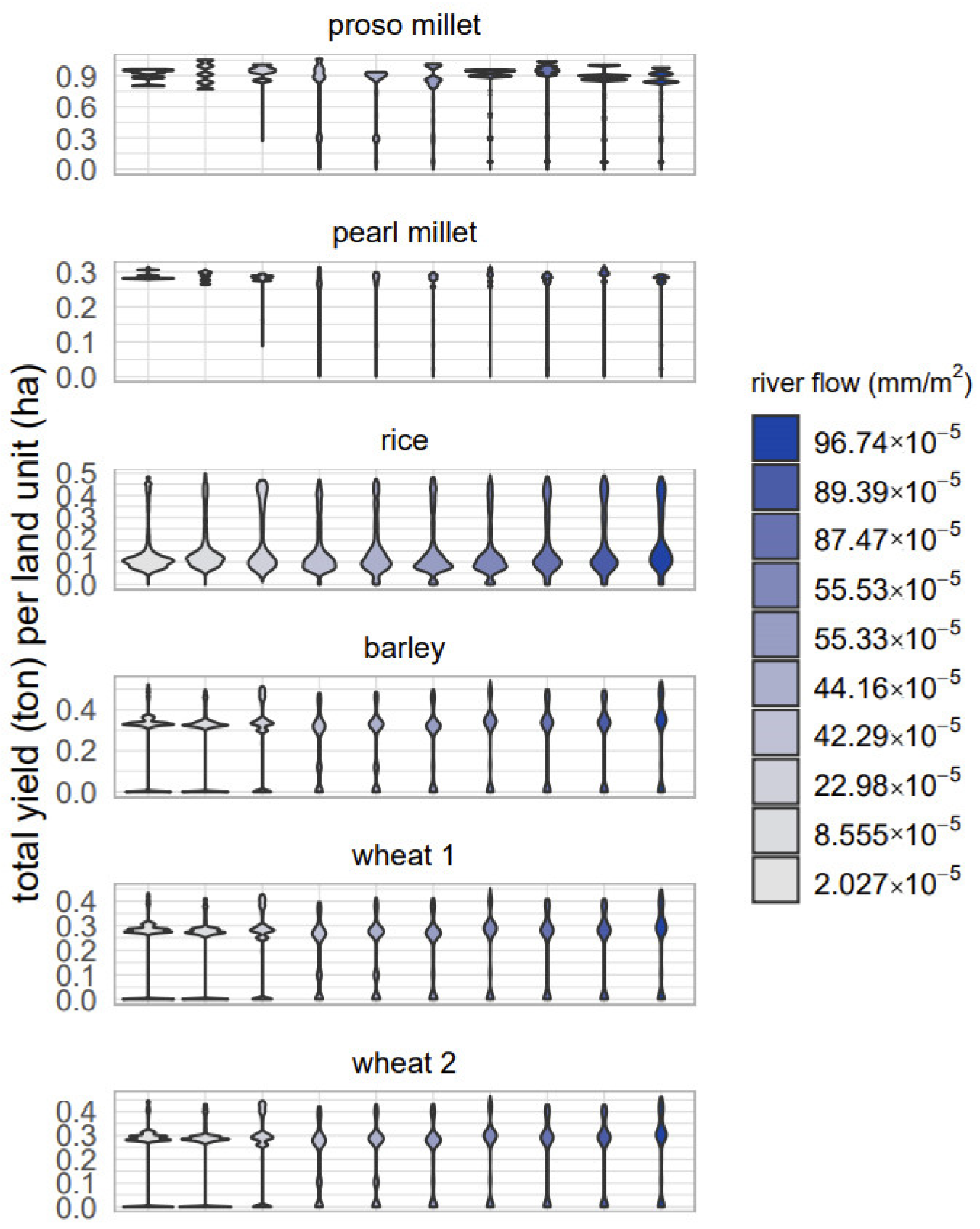

| Domain | Aspects to Model | Model |
|---|---|---|
| Climate | Solar radiation, temperature, and precipitation | Weather model |
| Land and soil | Soil properties, soil and surface water dynamics, and cover including vegetation | Soil water model, land model |
| Food production | Crop cultivation, with a strong focus on staple cereals, and animal husbandry, supported by fishing, hunting and gathering | Crop model, land use mechanisms |
| Population and social structure | Individuals organized in households, i.e., the social unit of co-habitation, production, consumption, reproduction and decision-making | Household agent set up |
| Population dynamics in terms of individual-based fertility, nuptiality, and mortality | Household demography model | |
| Households interact with each other and form larger groups and settlements | Household position model | |
| Diet and nutrition | Composition of foodstuffs consumed within a household and corresponding nutritional budget that regulates individual health | Nutrition model and food consumption mechanisms |
| Food economy | Processes involved in food production, beyond the procurement of raw foodstuffs, and distribution, storage, and exchange of foodstuffs | Food storage model, exchange model |
| Decision-making | Selection and revision of food production strategies at household level, particularly in terms of the triplet activity-conditions-investment, and other relevant aspects such as household position and the engagement with neighbors | Mechanisms connecting labor investments, land use, diet satisfaction, and cooperation in food economy (several models) |
| Cultivar | Species | ||||||||||||
|---|---|---|---|---|---|---|---|---|---|---|---|---|---|
| Crop 2 | z3 | ||||||||||||
| proso millet | 1328 | 0.29 | 157.3 | 96.75 | 0 | 18 | 3 | 100 | 5 | 34 | 45 | 0.05 | 1000 |
| pearl millet | 1220 | 0.25 | 245 | 120 | 10 | 33 | 1.9 | 100 | 5 | 35 | 47 | 0.05 | 1000 |
| rice | 2300 | 0.47 | 850 | 200 | 9 | 26 | 1.24 | 100 | 10 | 34 | 50 | 1 | 400 |
| barley | 1762 | 0.42 | 350 | 170 | 0 | 15 | 1.24 | 100 | 20 | 34 | 45 | 0.4 | 1000 |
| wheat 1 | 2200 | 0.36 | 480 | 200 | 0 | 15 | 1.24 | 100 | 25 | 34 | 45 | 0.4 | 1000 |
| wheat 2 | 2150 | 0.34 | 280 | 50 | 0 | 15 | 1.24 | 100 | 25 | 34 | 45 | 0.4 | 1000 |
| Submodel | Domain | Parameters | Unit | Default/Exp. 0, 1 | Exploration Range Exp. 2 |
|---|---|---|---|---|---|
| (all submodels) | time | year length in days | days | 365 | |
| Weather 2 | temperature | annualMaxAt2m | °C | 37.00 | |
| annualMinAt2m | °C | 12.80 | |||
| meanDailyFluctuation | °C | 2.20 | |||
| dailyLowerDeviation | °C | 6.80 | |||
| dailyUpperDeviation | °C | 7.90 | |||
| solar | annualMax | MJ | 24.20 | ||
| annualMin | MJ | 9.20 | |||
| meanDailyFluctuation | MJ | 3.30 | |||
| CO2 | annualMax | ppm | 245.00 | ||
| annualMin | ppm | 255.00 | |||
| meanDailyFluctuation | ppm | 1.00 | |||
| precipitation | yearlyMean | mm | 489.00 | 50–1000 | |
| yearlySd | mm | 142.20 | |||
| (cum. sum) | nSamples | - | 200 | ||
| maxSampleSize | days | 10 | |||
| plateauValue_yearlyMean | mm·mm−1 | 0.25 | 0.2–0.8 | ||
| plateauValue_yearlySd | mm·mm−1 | 0.10 | |||
| inflection1_yearlyMean | day of year | 40 | |||
| inflection1_yearlySd | days | 5 | |||
| rate1_yearlyMean | - | 0.07 | |||
| rate1_yearlySd | - | 0.02 | |||
| inflection2_yearlyMean | day of year | 240 | |||
| inflection2_yearlySd | days | 20 | |||
| rate2_yearlyMean | - | 0.08 | |||
| rate2_yearlySd | - | 0.02 | |||
| Soil water 3 | surface | elevation | m | 200 | |
| albedo | - | 0.23 | |||
| runoff curve number (CN) | - | 65 | |||
| soil | drainage coefficient (DC) | - | 0.55 | ||
| root zone depth (z) | mm | 400 | |||
| field capacity (FC) | mm·mm−1 | 0.21 | |||
| water holding capacity (WHC) | mm·mm−1 | 0.15 | |||
| wilting point (WP) | mm·mm−1 | 0.06 | |||
| water uptake coefficient (MUF) | mm3·mm3 | 0.096 | |||
| Crop | management | F_Solar_max | - | 0.95 |
| Terrain Random Seed | ||||||
|---|---|---|---|---|---|---|
| Domain | Parameters | 0 | 35 | 56 | 72 | 92 |
| elevation | algorithm-style | “C#” | “C#” | “C#” | “C#” | “C#” |
| numDepressions | 7 | 10 | 3 | 4 | 6 | |
| numProtuberances | 4 | 6 | 9 | 4 | 8 | |
| numRanges | 66 | 43 | 38 | 64 | 92 | |
| numRifts | 88 | 97 | 13 | 63 | 42 | |
| rangeAggregation | 0.6458941 | 0.1113466 | 0.8133660 | 0.5878475 | 0.8563670 | |
| rangeHeight | 21.18274020 | 40.86174048 | 17.72232293 | 20.63073219 | 0.01770265 | |
| rangeLength | 1888 | 961 | 680 | 1279 | 1659 | |
| riftAggregation | 0.3834415 | 0.6789708 | 0.3916585 | 0.5006789 | 0.9385805 | |
| riftHeight | −48.183138 | −34.108734 | −43.865071 | −3.337115 | −22.063655 | |
| riftLength | 3090 | 959 | 1589 | 601 | 1686 | |
| featureAngleRange | 15.866848 | 1.374065 | 2.702853 | 28.400278 | 25.210475 | |
| noise | 3.958625 | 3.983587 | 1.630667 | 2.160736 | 3.588394 | |
| smoothingRadius | 3.464823 | 3.464823 | 3.464823 | 3.464823 | 3.464823 | |
| smoothStep | 1 | 1 | 1 | 1 | 1 | |
| valleyAxisInclination | 0.0871293 | 0.9890636 | 0.5495040 | 0.6342591 | 0.2892803 | |
| valleySlope | 0.0004043679 | 0.0037176302 | 0.0169948110 | 0.0116752657 | 0.0080676211 | |
| xSlope | 0.009255966 | 0.002138160 | 0.000962116 | 0.002474697 | 0.008352354 | |
| ySlope | 0.0007103606 | 0.0030363731 | 0.0064754508 | 0.0040414184 | 0.0044743707 | |
| flow | do-fill-sinks | true | true | true | true | true |
| riverAccumulationAtStart2 | 42,173,154 | 22,337,132 | 6,731,985 | 13,792,828 | 9,956,658 | |
| soil | maxDepth | 561.0885 | 149.9677 | 491.1287 | 317.9024 | 464.0493 |
| minDepth | 267.5030 | 105.5965 | 270.2213 | 206.9417 | 229.0143 | |
| depthNoise | 39.957929 | 25.789514 | 35.632002 | 8.418835 | 43.506614 | |
| formativeErosionRate | 2.334470 | 2.250253 | 1.322605 | 1.850611 | 2.567509 | |
| max%sand | 88.181043 | 43.658762 | 5.469936 | 84.602521 | 53.606080 | |
| min%sand | 46.147936 | 39.425832 | 3.567197 | 74.532106 | 17.096166 | |
| max%silt | 68.25092 | 34.55299 | 70.62584 | 76.87028 | 98.18986 | |
| min%silt | 11.82744 | 33.82258 | 32.77969 | 66.05339 | 77.34002 | |
| max%clay | 95.26008 | 97.08764 | 93.12337 | 11.49762 | 42.96254 | |
| min%clay | 14.33533 | 76.75279 | 74.57170 | 6.94711 | 35.25457 | |
| textureNoise | 5.218483 | 5.335943 | 9.901911 | 4.416463 | 3.734752 | |
| ecology | woodFrequencyInflection | 39.26634 | 15.82286 | 35.38110 | 46.23942 | 19.50877 |
| woodFrequencyRate | 0.00287898 | 0.04129579 | 0.09413197 | 0.02204882 | 0.06864615 | |
| brushFrequencyInflection | 13.686815 | 7.990782 | 19.641344 | 7.067255 | 14.663800 | |
| brushFrequencyRate | 0.04661503 | 0.08916186 | 0.05192546 | 0.06610931 | 0.07624894 | |
| grassFrequencyInflection | 2.0733097 | 0.4220637 | 4.8174187 | 3.5072296 | 0.9123332 | |
| grassFrequencyRate | 0.053911121 | 0.165866239 | 0.111039067 | 0.158674553 | 0.002558042 | |
| Exploration Range | |||||
|---|---|---|---|---|---|
| Domain | Parameters | Unit | Default/Exp. 3 | Exp. 4 | Exp. 5 |
| terrain | seaLevelReferenceShift | m | −1000 | ||
| riverWaterPerFlowAccumulation1 | mm·m−2 | 10−4 | 10−5–10−3 | ||
| errorToleranceThreshold | mm·m−2 | 1 | |||
| crops | selection | - | [all crops in Table 2] | ||
| intensity | % of land unit | 50 | |||
| (land unit) | frequency | % of (effective) intensity | 100/6 | C(0, 1) 2 | |
| (array of <selection> items) | |||||
Publisher’s Note: MDPI stays neutral with regard to jurisdictional claims in published maps and institutional affiliations. |
© 2022 by the authors. Licensee MDPI, Basel, Switzerland. This article is an open access article distributed under the terms and conditions of the Creative Commons Attribution (CC BY) license (https://creativecommons.org/licenses/by/4.0/).
Share and Cite
Angourakis, A.; Bates, J.; Baudouin, J.-P.; Giesche, A.; Walker, J.R.; Ustunkaya, M.C.; Wright, N.; Singh, R.N.; Petrie, C.A. Weather, Land and Crops in the Indus Village Model: A Simulation Framework for Crop Dynamics under Environmental Variability and Climate Change in the Indus Civilisation. Quaternary 2022, 5, 25. https://doi.org/10.3390/quat5020025
Angourakis A, Bates J, Baudouin J-P, Giesche A, Walker JR, Ustunkaya MC, Wright N, Singh RN, Petrie CA. Weather, Land and Crops in the Indus Village Model: A Simulation Framework for Crop Dynamics under Environmental Variability and Climate Change in the Indus Civilisation. Quaternary. 2022; 5(2):25. https://doi.org/10.3390/quat5020025
Chicago/Turabian StyleAngourakis, Andreas, Jennifer Bates, Jean-Philippe Baudouin, Alena Giesche, Joanna R. Walker, M. Cemre Ustunkaya, Nathan Wright, Ravindra Nath Singh, and Cameron A. Petrie. 2022. "Weather, Land and Crops in the Indus Village Model: A Simulation Framework for Crop Dynamics under Environmental Variability and Climate Change in the Indus Civilisation" Quaternary 5, no. 2: 25. https://doi.org/10.3390/quat5020025
APA StyleAngourakis, A., Bates, J., Baudouin, J.-P., Giesche, A., Walker, J. R., Ustunkaya, M. C., Wright, N., Singh, R. N., & Petrie, C. A. (2022). Weather, Land and Crops in the Indus Village Model: A Simulation Framework for Crop Dynamics under Environmental Variability and Climate Change in the Indus Civilisation. Quaternary, 5(2), 25. https://doi.org/10.3390/quat5020025






